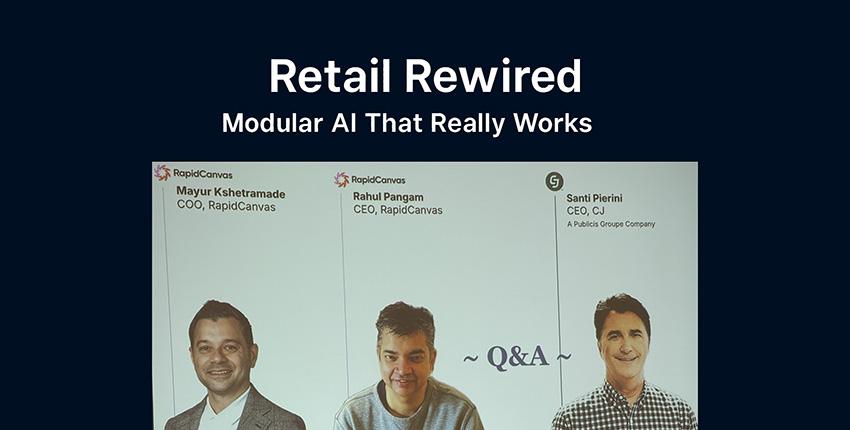Retail Rewired: Modular AI That Really Works
Ai4 Conference 2025 - Las Vegas: Retailers today face a familiar but intensifying challenge—mountains of fragmented data, siloed tools, and the pressure to make faster, smarter decisions. In the panel “Retail Rewired: Modular AI That Really Works”, industry leaders explored how plug-and-play, AI-powered solutions are helping brands forecast demand with greater accuracy, optimise pricing in real time, and personalise marketing—without the overhead of building in-house AI teams.
The discussion featured Rahul Pangam, CEO of RapidCanvas, and Santi Pierini, CEO of CJ, the world’s largest affiliate marketing platform. Moderated by RapidCanvas COO Mayur, the conversation combined practical case studies, proven adoption strategies, and a candid look at what works—and what doesn’t—across D2C, marketplaces, and omni-channel retail.
From Fragmentation to Forecasting
Mayur began by framing the retail AI landscape as one moving rapidly from experimentation to tangible ROI. “Change leaders who are using AI effectively are growing two to two and a half times faster,” he noted. These leaders tend to start in one of two ways:
1. Unlocking existing data – maximising the value of historical CRM records, market signals, and operational metrics.
2. Deploying agentic AI – augmenting human decision-making to improve efficiency and profitability without adding headcount.
He highlighted three core decision-driving use cases:
• Demand Forecasting – replacing clunky ERP tools and spreadsheets with AI models that integrate historical data and real-time market signals, leading to double-digit reductions in both overstock and stockouts.
• Targeted Marketing – using customer behaviour patterns, competitor activity, and in-market signals to create personalised outreach, improving retention and acquisition rates.
• Dynamic Pricing – adjusting prices based on sales performance, competitor moves, and margin rules to prevent losses and increase retention.
Beyond Spreadsheets: Agentic AI in Operations
The second set of examples showcased AI’s impact in back-office and support workflows:
• Finance Automation – matching invoices to payments with fuzzy logic, updating books automatically, and reducing month-end close times.
• Customer Support Triage – categorising tickets in real time to handle twice the volume without additional staff.
• End-to-End Planning Flywheel – integrating forecasting, procurement, production scheduling, and inventory tracking, delivering 90% planning accuracy and cutting spreadsheet use by 80%.
The takeaway: AI isn’t just about front-end optimisation—it can also eliminate bottlenecks in core operational processes.
Building Conviction for AI Investment
When asked how to prioritise AI opportunities, Santi Pierini was clear: “We don’t look at it as AI initiatives—we look at it as business transformation enabled by AI.” At CJ, AI is embedded across teams, from client services to engineering, with a goal of increasing productivity by 75% without diluting domain expertise.
Pierini framed AI not as a disruptor, but as a cure for the disruption retailers face from forces like retail media networks, social commerce, and shifting consumer channels. His “Dune” analogy stuck with the audience: AI can be the sandworm that consumes you, or the one you learn to ride.
In CJ’s case, riding that sandworm means managing an increasingly complex influencer and affiliate ecosystem. With tens of thousands of creators and multiple sales channels, AI is now essential for matchmaking the right product to the right campaign, measuring results, and forecasting performance.
Driving Adoption and Avoiding Pitfalls
Rahul Pangam underscored that 80% of AI projects struggle—not due to bad ideas, but because of poor implementation, adoption, and change management. His advice:
• Start small, scale fast – begin with pilots tied to high-priority business outcomes.
• Make it cross-functional – involve both business and technical teams from the outset to ensure shared accountability.
• Focus on KPIs – measure and adjust constantly to prove value.
Both CEOs agreed that success comes from embedding AI into the rhythm of the business, not treating it as a side project. The goal isn’t to showcase technology for technology’s sake, but to deliver measurable, repeatable business impact.
The Future: Trust, Speed, and Real Results
As Pierini reminded the audience, “The one thing AI can’t replace is trust.” Whether in affiliate marketing or personalised product recommendations, the consumer journey still hinges on credible, human-endorsed advice—AI’s role is to scale and sharpen that connection.
The session closed on a note of optimism. Retailers are more excited than afraid, and with modular AI, they no longer need massive in-house teams to see results. Plug-and-play solutions are helping brands cut waste, capture growth, and move at the pace of modern retail—no legacy BI required.
In a market defined by speed, complexity, and customer expectations, modular AI may not just be the future—it’s already what’s working today.









